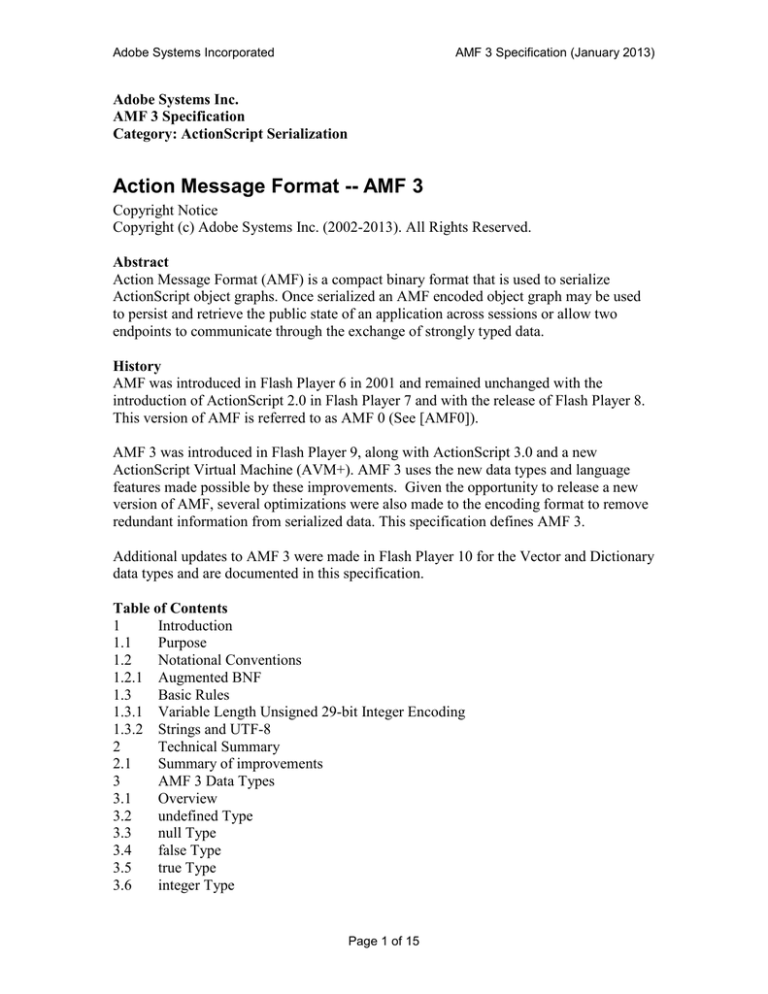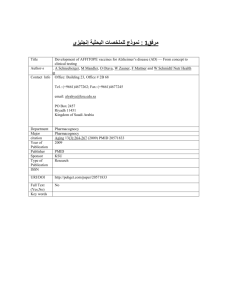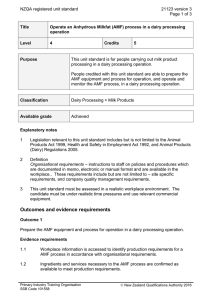
Adobe Systems Incorporated
AMF 3 Specification (January 2013)
Adobe Systems Inc.
AMF 3 Specification
Category: ActionScript Serialization
Action Message Format -- AMF 3
Copyright Notice
Copyright (c) Adobe Systems Inc. (2002-2013). All Rights Reserved.
Abstract
Action Message Format (AMF) is a compact binary format that is used to serialize
ActionScript object graphs. Once serialized an AMF encoded object graph may be used
to persist and retrieve the public state of an application across sessions or allow two
endpoints to communicate through the exchange of strongly typed data.
History
AMF was introduced in Flash Player 6 in 2001 and remained unchanged with the
introduction of ActionScript 2.0 in Flash Player 7 and with the release of Flash Player 8.
This version of AMF is referred to as AMF 0 (See [AMF0]).
AMF 3 was introduced in Flash Player 9, along with ActionScript 3.0 and a new
ActionScript Virtual Machine (AVM+). AMF 3 uses the new data types and language
features made possible by these improvements. Given the opportunity to release a new
version of AMF, several optimizations were also made to the encoding format to remove
redundant information from serialized data. This specification defines AMF 3.
Additional updates to AMF 3 were made in Flash Player 10 for the Vector and Dictionary
data types and are documented in this specification.
Table of Contents
1
Introduction
1.1
Purpose
1.2
Notational Conventions
1.2.1 Augmented BNF
1.3
Basic Rules
1.3.1 Variable Length Unsigned 29-bit Integer Encoding
1.3.2 Strings and UTF-8
2
Technical Summary
2.1
Summary of improvements
3
AMF 3 Data Types
3.1
Overview
3.2
undefined Type
3.3
null Type
3.4
false Type
3.5
true Type
3.6
integer Type
Page 1 of 15
Adobe Systems Incorporated
3.7
3.8
3.9
3.10
3.11
3.12
3.13
3.14
3.15
3.16
4
4.1
4.1.1
4.2
5
AMF 3 Specification (January 2013)
double Type
String Type
XMLDocument Type
Date Type
Array Type
Object Type
XML Type
ByteArray Type
Vector Type
Dictionary Type
Usages of AMF 3
NetConnection and AMF 3
NetConnection in ActionScript 3.0
ByteArray, IDataInput and IDataOutput
Normative References
1 Introduction
1.1 Purpose
Action Message Format (AMF) is a compact binary format that is used to serialize
ActionScript object graphs. Once serialized an AMF encoded object graph may be used
to persist and retrieve the public state of an application across sessions or allow two
endpoints to communicate through the exchange of strongly typed data. The first version
of AMF, referred to as AMF 0, supports sending complex objects by reference which
helps to avoid sending redundant instances in an object graph. It also allows endpoints to
restore object relationships and support circular references while avoiding problems such
as infinite recursion during serialization. A new version of AMF, referred to as AMF 3 to
coincide with the release of ActionScript 3.0, improves on AMF 0 by sending object
traits and strings by reference in addition to object instances. AMF 3 also supports some
new data types introduced in ActionScript 3.0.
1.2 Notational Conventions
1.2.1 Augmented BNF
Type definitions in this specification use Augmented Backus-Naur Form (ABNF) syntax
[RFC2234]. The reader should be familiar with this notation before reading this
document.
1.3 Basic Rules
Throughout this document bytes are assumed to be octets, or 8-bits.
U8
U16
=
=
U32
=
An unsigned byte (8-bits, an octet)
An unsigned 16-bit integer in big endian
(network) byte order
An unsigned 32-bit integer in big endian (network)
byte order
Page 2 of 15
Adobe Systems Incorporated
DOUBLE
=
MB
=
AMF 3 Specification (January 2013)
8 byte IEEE-754 double precision floating point
value in network byte order (sign bit in low
memory).
A megabyte or 1048576 bytes.
More complicated data type rules require special treatment which is outlined below.
1.3.1 Variable Length Unsigned 29-bit Integer Encoding
AMF 3 makes use of a special compact format for writing integers to reduce the number
of bytes required for encoding. As with a normal 32-bit integer, up to 4 bytes are required
to hold the value however the high bit of the first 3 bytes are used as flags to determine
whether the next byte is part of the integer. With up to 3 bits of the 32 bits being used as
flags, only 29 significant bits remain for encoding an integer. This means the largest
unsigned integer value that can be represented is 229 - 1.
(hex)
0x00000000 - 0x0000007F
0x00000080 - 0x00003FFF
0x00004000 - 0x001FFFFF
0x00200000 - 0x3FFFFFFF
0x40000000 - 0xFFFFFFFF
:
:
:
:
:
:
(binary)
0xxxxxxx
1xxxxxxx 0xxxxxxx
1xxxxxxx 1xxxxxxx 0xxxxxxx
1xxxxxxx 1xxxxxxx 1xxxxxxx xxxxxxxx
throw range exception
In ABNF syntax, the variable length unsigned 29-bit integer type is described as follows:
U29
U29-1
U29-2
U29-3
U29-4
=
=
=
=
=
U29-1 |
%x00-7F
%x80-FF
%x80-FF
%x80-FF
U29-2 | U29-3 | U29-4
%x00-7F
%x80-FF %x00-7F
%x80-FF %x80-FF %x00-FF
1.3.2 Strings and UTF-8
AMF 0 and AMF 3 use (non-modified) UTF-8 to encode strings. UTF-8 is the
abbreviation for 8-bit Unicode Transformation Format. UTF-8 strings are typically
preceded with a byte-length header followed by a sequence of variable length (1 to 4
octets) encoded Unicode code-points. AMF 3 uses a slightly modified byte-length header;
a detailed description is provided below and referred to throughout the document.
(hex)
0x00000000 - 0x0000007F
0x00000080 - 0x000007FF
0x00000800 - 0x0000FFFF
0x00010000 - 0x0010FFFF
:
:
:
:
:
(binary)
0xxxxxxx
110xxxxx 10xxxxxx
1110xxxx 10xxxxxx 10xxxxxx
11110xxx 10xxxxxx 10xxxxxx 10xxxxxx
In ABNF syntax, [RFC3629] describes UTF-8 as follows:
UTF8-char
=
UTF8-1 | UTF8-2 | UTF8-3 | UTF8-4
Page 3 of 15
Adobe Systems Incorporated
UTF8-1
UTF8-2
UTF8-3
=
=
=
UTF8-4
=
UTF8-tail
=
AMF 3 Specification (January 2013)
%x00-7F
%xC2-DF UTF8-tail
%xE0 %xA0-BF UTF8-tail | %xE1-EC 2(UTF8-tail) |
%xED %x80-9F UTF8-tail | %xEE-EF 2(UTF8-tail)
%xF0 %x90-BF 2(UTF8-tail) | %xF1-F3 3(UTF8-tail) |
%xF4 %x80-8F 2(UTF8-tail)
%x80-BF
For AMF 3 a string can be encoded as a string literal or a string reference. A variable
length unsigned 29-bit integer is used for the header and the first bit is flag that specifies
which type of string is encoded. If the flag is 1, a string literal is encoded and the
remaining bits are used to encode the byte-length of the UTF-8 encoded String. If the flag
is 0, then a string reference is encoded and the remaining bits are used to encode an index
to the implicit string reference table.
U29S-ref
=
U29
;
;
;
;
;
The first (low) bit is a flag with
value 0. The remaining 1 to 28
significant bits are used to encode a
string reference table index (an
integer).
U29S-value
=
U29
;
;
;
;
;
The first (low) bit is a flag with
value 1. The remaining 1 to 28
significant bits are used to encode the
byte-length of the UTF-8 encoded
representation of the string
UTF-8-empty =
0x01
; The UTF-8-vr empty string which is
; never sent by reference.
UTF-8-vr
U29S-ref | (U29S-value *(UTF8-char))
=
Note that this encoding imposes some theoretical limits on the use of Strings. The
number of unique Strings that can be sent by reference is limited to 228 - 1, and the bytelength of each UTF-8 encoded String is limited to 228 - 1 bytes (approx 256 MB).
2. Technical Summary
2.1 Summary of improvements
The following is a table of the improvements and changes in AMF 3:
•
•
•
•
•
•
Object traits can now be sent by reference
Strings can now be sent by reference
int/uint type support
flash.utils.ByteArray type support, can also be sent by reference
flash.utils.IExternalizable support
Variable length encoding scheme for integers to reduce data size
Page 4 of 15
Adobe Systems Incorporated
•
•
•
•
•
•
•
•
•
•
•
•
•
•
AMF 3 Specification (January 2013)
References are sent using variable length integer
String UTF-8 length uses variable length integer
Array count uses variable length integer
A single Array type marker covers both strict and ECMA Arrays
Dates no longer send timezone information
Dates can now be sent by reference
XMLDocument UTF-8 length uses variable length integer
XMLDocument can now be sent by reference
XML type support, can also be sent by reference
XML UTF-8 length uses variable length integer
ByteArray type length uses variable length integer
Boolean true and false are now sent as one byte type markers
Unsupported type marker has been removed
Reserved RecordSet and Movieclip type markers have been removed
2.2 Reference Tables
In AMF 3, Strings, Complex Objects (which in AMF 3 are defined as anonymous
Objects, typed Objects, Arrays, Dates, XMLDocument, XML, and ByteArrays) and an
Object Type's Traits can now be sent by reference. This means that instead of sending
redundant information, these components of AMF can simply refer to an earlier
occurrence of a component. This reference is an integer forming a zero-based index that
is encoded in the component information, typically in the first number that appears after
the relevant type marker (see the type definitions for Object, Array, Date,
XMLDocument, XML and ByteArray below for exact details). These indexes form a
virtual "table" of references that a deserializer and serializer must maintain when reading
and writing AMF 3 formatted data.
Note that 3 separate reference tables are used for Strings, Complex Objects and
Object Traits respectively.
3 AMF 3 Data Types
3.1 Overview
There are 13 types in AMF 3. A type marker is one byte in length and describes the type
of encoded data that follows.
marker
=
U8
The set of possible type markers are listed below (values are represented in hexadecimal
format):
undefined-marker
null-marker
false-marker
true-marker
integer-marker
=
=
=
=
=
0x00
0x01
0x02
0x03
0x04
Page 5 of 15
Adobe Systems Incorporated
AMF 3 Specification (January 2013)
double-marker
string-marker
xml-doc-marker
date-marker
array-marker
object-marker
xml-marker
byte-array-marker
vector-int-marker
vector-uint-marker
vector-double-marker
vector-object-marker
dictionary-marker
=
=
=
=
=
=
=
=
=
=
=
=
=
0x05
0x06
0x07
0x08
0x09
0x0A
0x0B
0x0C
0x0D
0x0E
0x0F
0x10
0x11
Type markers may be followed by the actual encoded type data, or if the marker
represents a single possible value (such as null) then no further information needs to be
encoded.
value-type
=
undefined-marker | null-marker | false-marker |
true-marker | integer-type | double-type |
string-type | xml-doc-type | date-type |
array-type | object-type | xml-type | byte-arraytype | vector-int-type | vector-uint-type |
vector-double-type | vector-object-type |
dictionary-type
AMF 3 makes use of three reference tables for strings, objects and traits (the
characteristics of objects that define a strong type such as the class name and public
member names). These tables are considered implicit as they are not encoded as a unique
entity in the format. Each type that can be sent by reference may instead be encoded
using an index to the appropriate reference table. Strings can be sent by reference using
an index to the string table. Object, Array, XML, XMLDocument, ByteArray, Date and
instances of user defined Classes can be sent by reference using an index to the object
table. Objects and instances of user defined Classes have trait information which can also
be sent by reference using an index to the traits table.
3.2 undefined Type
The undefined type is represented by the undefined type marker. No further information
is encoded for this value.
undefined-type
=
undefined-marker
Note that endpoints other than the AVM may not have the concept of undefined and may
choose to represent undefined as null.
3.3 null Type
The null type is represented by the null type marker. No further information is encoded
for this value.
Page 6 of 15
Adobe Systems Incorporated
null-type
AMF 3 Specification (January 2013)
=
null-marker
3.4 false Type
The false type is represented by the false type marker and is used to encode a Boolean
value of false. Note that in ActionScript 3.0 the concept of a primitive and Object form of
Boolean does not exist. No further information is encoded for this value.
false-type
=
false-marker
3.5 true type
The true type is represented by the true type marker and is used to encode a Boolean
value of true. Note that in ActionScript 3.0 the concept of a primitive and Object form of
Boolean does not exist. No further information is encoded for this value.
true-type
=
true-marker
3.6 integer type
In AMF 3 integers are serialized using a variable length 29-bit value, although unlike
other U29 values in AMF, integer values are stored as signed values. If the value of an
unsigned integer (uint) or signed integer (int) is greater than or equal to 228, or if a signed
integer (int) is less than -228, it will be serialized using the AMF 3 double type.
Note: this means the original type information of the data is potentially lost (though it
may be possible to correct on deserialization when such values are assigned to strongly
typed members of a class and coerced to a specified type).
integer-type
= integer-marker U29
; Uses the U29 encoding scheme,
; though the value is sign
; extended.
3.7 double type
The AMF 3 double type is encoded in the same manner as the AMF 0 Number type. This
type is used to encode an ActionScript Number or an ActionScript int of value greater
than or equal to 228 or an ActionScript uint of value greater than or equal to 229. The
encoded value is always an 8 byte IEEE-754 double precision floating point value in
network byte order (sign bit in low memory).
double-type
=
double-marker DOUBLE
3.8 String type
ActionScript String values are represented using a single string type in AMF 3 - the
concept of string and long string types from AMF 0 is not used.
Strings can be sent as a reference to a previously occurring String by using an index to
the implicit string reference table.
Page 7 of 15
Adobe Systems Incorporated
AMF 3 Specification (January 2013)
Strings are encoding using UTF-8 - however the header may either describe a string
literal or a string reference.
The empty String is never sent by reference.
string-type
=
string-marker UTF-8-vr
3.9 XMLDocument type
ActionScript 3.0 introduced a new XML type (see 3.13) however the legacy
XMLDocument type is retained in the language as flash.xml.XMLDocument. Similar to
AMF 0, the structure of an XMLDocument needs to be flattened into a string
representation for serialization. As with other strings in AMF, the content is encoded in
UTF-8.
XMLDocuments can be sent as a reference to a previously occurring XMLDocument
instance by using an index to the implicit object reference table.
U29X-value
=
U29
;
;
;
;
;
;
The first (low) bit is a flag with
value 1. The remaining 1 to 28
significant bits are used to encode the
byte-length of the UTF-8 encoded
representation of the XML or
XMLDocument.
xml-doc-type
=
xml-doc-marker (U29O-ref | (U29X-value
*(UTF8-char)))
Note that this encoding imposes some theoretical limits on the use of XMLDocument.
The byte-length of each UTF-8 encoded XMLDocument instance is limited to 228 - 1
bytes (approx 256 MB).
3.10 Date type
In AMF 3 an ActionScript Date is serialized simply as the number of milliseconds
elapsed since the epoch of midnight, 1st Jan 1970 in the UTC time zone. Local time zone
information is not sent.
Dates can be sent as a reference to a previously occurring Date instance by using an index
to the implicit object reference table.
U29D-value
=
U29
; The first (low) bit is a flag with
; value 1. The remaining bits are not
; used.
date-time
=
DOUBLE
; A 64-bit integer value transported
; as a double.
date-type
=
date-marker (U29O-ref | (U29D-value date-time))
Page 8 of 15
Adobe Systems Incorporated
AMF 3 Specification (January 2013)
3.11 Array type
ActionScript Arrays are described based on the nature of their indices, i.e. their type and
how they are positioned in the Array. The following table outlines the terms and their
meaning:
strict
dense
sparse
associative
contains only ordinal (numeric) indices
ordinal indices start at 0 and do not contain gaps between successive
indices (that is, every index is defined from 0 for the length of the array)
contains at least one gap between two indices
contains at least one non-ordinal (string) index (sometimes referred to as
an ECMA Array)
AMF considers Arrays in two parts, the dense portion and the associative portion. The
binary representation of the associative portion consists of name/value pairs (potentially
none) terminated by an empty string. The binary representation of the dense portion is the
size of the dense portion (potentially zero) followed by an ordered list of values
(potentially none). The order these are written in AMF is first the size of the dense
portion, an empty string terminated list of name/value pairs, followed by size values.
Arrays can be sent as a reference to a previously occurring Array by using an index to the
implicit object reference table.
U29A-value
=
U29
;
;
;
;
;
The first (low) bit is a flag with
value 1. The remaining 1 to 28
significant bits are used to encode the
count of the dense portion of the
Array.
assoc-value =
UTF-8-vr value-type
array-type
array-marker (U29O-ref | (U29A-value
(UTF-8-empty | *(assoc-value) UTF-8-empty)
*(value-type)))
=
3.12 Object type
A single AMF 3 type handles ActionScript Objects and custom user classes. The term
'traits' is used to describe the defining characteristics of a class. In addition to
'anonymous' objects and 'typed' objects, ActionScript 3.0 introduces two further traits to
describe how objects are serialized, namely 'dynamic' and 'externalizable'. The following
table outlines the terms and their meanings:
Anonymous
Typed
Dynamic
an instance of the actual ActionScript Object type or an instance of a
Class without a registered alias (that will be treated like an Object on
deserialization)
an instance of a Class with a registered alias
an instance of a Class definition with the dynamic trait declared; public
variable members can be added and removed from instances
Page 9 of 15
Adobe Systems Incorporated
Externalizable
AMF 3 Specification (January 2013)
dynamically at runtime
an instance of a Class that implements flash.utils.IExternalizable and
completely controls the serialization of its members (no property names
are included in the trait information).
In addition to these characteristics, an object's traits information may also include a set of
public variable and public read-writeable property names defined on a Class (i.e. public
members that are not Functions). The order of the member names is important as the
member values that follow the traits information will be in the exact same order. These
members are considered sealed members as they are explicitly defined by the type.
If the type is dynamic, a further section may be included after the sealed members that
lists dynamic members as name / value pairs. One continues to read in dynamic members
until a name that is the empty string is encountered.
Objects can be sent as a reference to a previously occurring Object by using an index to
the implicit object reference table. Further more, trait information can also be sent as a
reference to a previously occurring set of traits by using an index to the implicit traits
reference table.
U29O-ref
=
U29
;
;
;
;
;
;
;
The first (low) bit is a flag
(representing whether an instance
follows) with value 0 to imply that
this is not an instance but a
reference. The remaining 1 to 28
significant bits are used to encode an
object reference index (an integer).
U29O-traits-ref
=
U29
;
;
;
;
;
;
;
;
;
The first (low) bit is a flag with
value 1. The second bit is a flag
(representing whether a trait
reference follows) with value 0 to
imply that this objects traits are
being sent by reference. The remaining
1 to 27 significant bits are used to
encode a trait reference index (an
integer).
U29O-traits-ext
=
U29
;
;
;
;
;
;
;
The first (low) bit is a flag with
value 1. The second bit is a flag with
value 1. The third bit is a flag with
value 1. The remaining 1 to 26
significant bits are not significant
(the traits member count would always
be 0).
U29O-traits
=
U29
; The first (low) bit is a flag with
; value 1. The second bit is a flag with
; value 1. The third bit is a flag with
Page 10 of 15
Adobe Systems Incorporated
AMF 3 Specification (January 2013)
;
;
;
;
;
;
;
;
;
;
;
value 0. The fourth bit is a flag
specifying whether the type is
dynamic. A value of 0 implies not
dynamic, a value of 1 implies dynamic.
Dynamic types may have a set of name
value pairs for dynamic members after
the sealed member
section. The
remaining 1 to 25 significant bits are
used to encode the number of sealed
traits member names that follow after
the class name (an integer).
class-name
=
UTF-8-vr
; Note: use the empty string for
; anonymous classes.
dynamic-member
=
UTF-8-vr
value-type
; Another dynamic member follows
; until the string-type is the
; empty string.
object-type
=
object-marker (U29O-ref | (U29O-traits-ext
class-name *(U8)) | U29O-traits-ref | (U29Otraits class-name *(UTF-8-vr))) *(value-type)
*(dynamic-member)))
Note that for U29O-traits-ext, after the class-name follows an indeterminable
number of bytes as *(U8). This represents the completely custom serialization of
"externalizable" types. The client and server have an agreement as to how to read in this
information.
3.13 XML type
ActionScript 3.0 introduces a new XML type that supports E4X syntax. For serialization
purposes the XML type needs to be flattened into a string representation. As with other
strings in AMF, the content is encoded using UTF-8.
XML instances can be sent as a reference to a previously occurring XML instance by
using an index to the implicit object reference table.
xml-type
=
xml-marker (U29O-ref |
(U29X-value *(UTF8-char)))
Note that this encoding imposes some theoretical limits on the use of XML. The bytelength of each UTF-8 encoded XML instance is limited to 228 - 1 bytes (approx 256 MB).
3.14 ByteArray type
ActionScript 3.0 introduces a new type to hold an Array of bytes, namely ByteArray.
AMF 3 serializes this type using a variable length encoding 29-bit integer for the bytelength prefix followed by the raw bytes of the ByteArray.
Page 11 of 15
Adobe Systems Incorporated
AMF 3 Specification (January 2013)
ByteArray instances can be sent as a reference to a previously occurring ByteArray
instance by using an index to the implicit object reference table.
U29B-value
=
bytearray-type
U29
=
;
;
;
;
The first (low) bit is a flag with
value 1. The remaining 1 to 28
significant bits are used to encode the
byte-length of the ByteArray.
bytearray-marker (U29O-ref | U29B-value *(U8))
Note that this encoding imposes some theoretical limits on the use of ByteArray. The
maximum byte-length of each ByteArray instance is limited to 228 - 1 bytes (approx. 256
MB).
3.15 Vector Type
A new Vector type was added to ActionScript 3.0 in Flash Player 10 to improve the
performance of accessing and iterating a collection of values. A Vector is a dense array
of values of the same type. This type is known as the Vector's base type. There are three
specializations of Vector for the int, uint or Number (i.e. a double) base types that allow
for an optimized representation. Otherwise, a Vector of "objects" can be constructed for
any base type, including '*' (i.e. the ANY Type, allowing for undefined values), Object,
or a custom ActionScript type (including a Vector, which allows for a Vector of Vectors).
Only Vectors of serializable types can be serialized.
A Vector can be set as fixed length or variable length on construction.
As with other objects, Vector instances can be sent as a reference to a previously
occurring Vector by using an index to the implicit object reference table.
U29V-value
=
U29
;
;
;
;
;
;
;
;
;
;
The first (low) bit is a flag
with value 1. The remaining 1
to 28 significant bits are
used to encode the count of
items in Vector.
Boolean U8 value, 0x00 if not
a fixed-length Vector,
otherwise 0x01 if
fixed-length.
uses '*' for the ANY type
fixed-vector
=
U8
object-type-name
=
UTF-8-vr
vector-int-type
=
vector-uint-type
=
vector-double-type
=
vector-int-marker (U29O-ref | U29V-value
fixed-vector *(U32))
vector-uint-marker (U29O-ref | U29V-value
fixed-vector *(U32))
vector-double-marker (U29O-ref | U29V-
Page 12 of 15
Adobe Systems Incorporated
vector-object-type
AMF 3 Specification (January 2013)
=
value fixed-vector *(DOUBLE))
vector-object-marker (U29O-ref |
U29V-value fixed-vector object-type-name
*(value-type))
Note that this encoding imposes some theoretical limits on the use of Vector. The
maximum length of each serialized Vector is limited to 228 - 1 items (some 268,435,455
values).
3.16 Dictionary Type
A new flash.utils.Dictionary type was added to ActionScript 3.0 in Flash Player 10. A
Dictionary is a map of key-value pairs, where both the key and value can be objects (i.e.
keys do not have to be strings). Keys are matched based on identity using a strict-equality
(===) comparison.
A Dictionary can be set to only maintain a weak reference to keys on construction. Weak
references allow objects to be garbage collected if the only reference to them is from the
Dictionary. An exception to this is mentioned in the AS3 Language Reference in that
String keys are always strongly referenced.
Only Dictionaries of serializable types can be serialized. The AS3 Language Reference
also reminds the developer that QNames cannot be used as Dictionary keys.
As with other objects, Dictionary instances can be sent as a reference to a previously
occurring Dictionary by using an index to the implicit object reference table.
U29Dict-value
=
U29
;
;
;
;
;
;
;
;
;
;
;
;
;
;
;
The first (low) bit is a
flag with value 1. The
remaining 1 to 28
significant bits are used to
encode the number of entries
in the Dictionary.
Boolean U8 value, 0x00 if
not using weakly-referenced
keys, otherwise 0x01 if
using weakly-referenced
keys.
Keys can be objects and do
not have to be strings.
Though see note about
integer keys below.
weak-keys
=
U8
entry-key
=
value-type
entry-value
=
value-type
dictionary-type
=
dictionary-marker (U29O-ref |
U29Dict-value weak-keys *(entry-key
entry-value))
Page 13 of 15
Adobe Systems Incorporated
AMF 3 Specification (January 2013)
Note: while the Flash Player may attempt to keep integer keys as integers at runtime, on
serialization these integer keys are serialized as Strings using their base-10
representation.
Also note that this encoding imposes some theoretical limits on the use of Dictionary.
The maximum number of entries in a serialized Dictionary is limited to 228 - 1 items
(some 268,435,455 key-value pairs).
4. Usages of AMF 3
4.1 NetConnection and AMF 3
In addition to serializing ActionScript types, AMF can be used in the asynchronous
invocations of remote services. A simple messaging structure is used to send a batch of
requests to a remote endpoint. The format of this messaging structure is AMF 0 (See
[AMF0]. A context header value or message body can switch to AMF 3 encoding using
the special avmplus-object-marker type.
Similar to AMF 0, AMF 3 object reference tables, object trait reference tables and string
reference tables must be reset each time a new context header or message is processed.
4.1.1 NetConnection in ActionScript 3.0
The qualified class name for NetConnection in ActionScript 3.0 is
flash.net.NetConnection. This class continues to use a responder to handle result and
status responses from a remote endpoint, however, a strongly typed Responder class is
now required. The fully qualified class name is flash.net.Responder. For events other than
normal result and status responses NetConnection dispatches events for which the
developer can add listeners. These events are outlined below:
asyncError
ioError
netStatus
securityError
Dispatched when an exception is thrown asynchronously - i.e. from
native asynchronous code.
Dispatched when an input or output error occurs that causes a network
operation to fail.
Dispatched when a NetConnection object is reporting its status or error
condition.
Dispatched if a call to NetConnection.call() attempts to connect to a
server outside the caller's security sandbox.
To handle an AMF context header a suitable method needs to be available, matching the
header name. NetConnection is now a sealed type so either it must be subclassed or an
object with a suitable implementation needs to be set for the NetConnection client
property.
Page 14 of 15
Adobe Systems Incorporated
AMF 3 Specification (January 2013)
4.2 ByteArray, IDataInput and IDataOutput
ActionScript 3.0 introduced a new type to support the manipulation of raw data in the
form of an Array of bytes, namely flash.utils.ByteArray. To assist with ActionScript
Object serialization and copying, ByteArray implements flash.utils.IDataInput and
flash.utils.IDataOutput. These interfaces specify utility methods that help write common
types to byte streams. Two methods of interest are IDataOutput.writeObject and
IDataInput.readObject. These methods encode objects using AMF. The version of AMF
used to encode object data is controlled by the ByteArray.objectEncoding method, which
can be set to either AMF 3 or AMF 0. An enumeration type, flash.net.ObjectEncoding,
holds the constants for the versions of AMF - ObjectEncoding.AMF0 and
ObjectEncoding.AMF3 respectively.
Note that ByteArray.writeObject uses one version of AMF to encode the entire object.
Unlike NetConnection, ByteArray does not start out in AMF 0 and switch to AMF 3
(with the objectEncoding property set to AMF 3). Also note that ByteArray uses a new
set of implicit reference tables for objects, object traits and strings for each readObject
and writeObject call.
5. Normative References
[AMF0]
[RFC2234]
[RFC3629]
Adobe Systems Inc. "Action Message Format - AMF 0", June 2006.
D. Crocker., et. al. "Augmented BNF for Syntax Specifications: ABNF",
RFC 2234, November 1997.
Yergeau, F., "UTF-8, a transformation format of ISO 10646", RFC 3629,
November 2003.
Page 15 of 15






